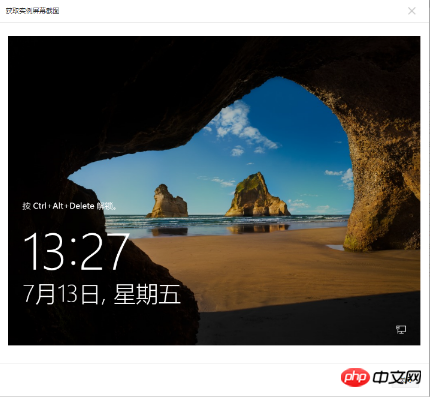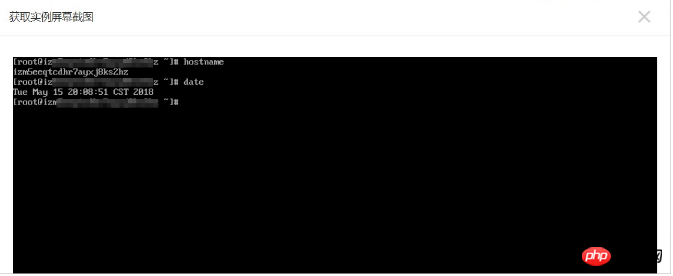 Operation and Maintenance
Operation and Maintenance
 Linux Operation and Maintenance
Linux Operation and Maintenance
 How to use system logs and real-time acquisition of instance screenshots to analyze and troubleshoot instance faults
How to use system logs and real-time acquisition of instance screenshots to analyze and troubleshoot instance faults
How to use system logs and real-time acquisition of instance screenshots to analyze and troubleshoot instance faults
This article introduces how to use system logs and real-time acquisition of instance screenshots to analyze and troubleshoot instance faults, and focuses on the specific steps. The content of this article is very compact, and I hope you will study patiently.
System logs and screenshots
Cloud server ECS is a virtualized cloud service. You cannot access a display device or manually take screenshots. However, ECS caches the system logs of the latest instance startup, restart, or shutdown, and supports obtaining instance screenshots in real time. You can use these functions to analyze and troubleshoot instance faults, such as diagnosing unresponsive operating systems, abnormal restarts, or inability to connect to the instance.
System log
The system log of cloud server ECS is an important part of operation and maintenance diagnosis. If you need to diagnose and analyze abnormal failures, you can obtain log information such as ECS instance startup and abnormal failures. The logs printed by the system through the serial port will contain two types of information, one is the log content when the system is started, and the other is the log content when the system kernel fails or is abnormal. For more details, please refer to the Yunqi Community Blog Is there something abnormal in the operating system? Diagnostic logs to help.
Usage restrictions
Windows instances can only obtain screenshots, but cannot obtain system logs.
Instance specifications that have been discontinued do not support obtaining instance system logs and screenshots.
Instances created before January 1, 2018 do not support obtaining system logs and screenshots.
Prerequisites
The instance must be in the Running state to obtain system logs and screenshots. For more details, see Connection Instance Overview.
Operation steps
You can view instance logs and instance screenshots through the console instance details page, console instance list page, or API.
Console instance details page operations
Log in to the ECS management console.
Click Instances in the left navigation bar.
Select a region.
Select the instance that needs to be troubleshooted and click the instance to enter the instance details page.
Click More > Get Instance Screenshot to view the screenshot, or click More > Get Instance System Log to view the log.
View instance screenshots or instance system logs.
Windows instance screenshot example:

Linux instance screenshot example:

Linux instance System log example:

Console instance list page operation
Log in to the ECS management console.
Click Instances in the left navigation bar.
Select a region.
Find the Operation menu of the instance that needs to troubleshoot abnormal faults.
Click More > Operations & Diagnostics > Get instance screenshots to view screenshots, or click More > Operations & Diagnostics > Get instance system logs to view logs.
View instance screenshots or instance system logs.
API operation
Get instance screenshot: GetInstanceScreenshot
Get instance system log: GetInstanceConsoleOutput
Next step
You may want to troubleshoot:
Unable to connect to Windows instance
Unable to connect to Linux instance
The above is the detailed content of How to use system logs and real-time acquisition of instance screenshots to analyze and troubleshoot instance faults. For more information, please follow other related articles on the PHP Chinese website!

Hot AI Tools

Undresser.AI Undress
AI-powered app for creating realistic nude photos

AI Clothes Remover
Online AI tool for removing clothes from photos.

Undress AI Tool
Undress images for free

Clothoff.io
AI clothes remover

AI Hentai Generator
Generate AI Hentai for free.

Hot Article

Hot Tools

Notepad++7.3.1
Easy-to-use and free code editor

SublimeText3 Chinese version
Chinese version, very easy to use

Zend Studio 13.0.1
Powerful PHP integrated development environment

Dreamweaver CS6
Visual web development tools

SublimeText3 Mac version
God-level code editing software (SublimeText3)

Hot Topics
 1381
1381
 52
52
 Difference between centos and ubuntu
Apr 14, 2025 pm 09:09 PM
Difference between centos and ubuntu
Apr 14, 2025 pm 09:09 PM
The key differences between CentOS and Ubuntu are: origin (CentOS originates from Red Hat, for enterprises; Ubuntu originates from Debian, for individuals), package management (CentOS uses yum, focusing on stability; Ubuntu uses apt, for high update frequency), support cycle (CentOS provides 10 years of support, Ubuntu provides 5 years of LTS support), community support (CentOS focuses on stability, Ubuntu provides a wide range of tutorials and documents), uses (CentOS is biased towards servers, Ubuntu is suitable for servers and desktops), other differences include installation simplicity (CentOS is thin)
 How to install centos
Apr 14, 2025 pm 09:03 PM
How to install centos
Apr 14, 2025 pm 09:03 PM
CentOS installation steps: Download the ISO image and burn bootable media; boot and select the installation source; select the language and keyboard layout; configure the network; partition the hard disk; set the system clock; create the root user; select the software package; start the installation; restart and boot from the hard disk after the installation is completed.
 Centos stops maintenance 2024
Apr 14, 2025 pm 08:39 PM
Centos stops maintenance 2024
Apr 14, 2025 pm 08:39 PM
CentOS will be shut down in 2024 because its upstream distribution, RHEL 8, has been shut down. This shutdown will affect the CentOS 8 system, preventing it from continuing to receive updates. Users should plan for migration, and recommended options include CentOS Stream, AlmaLinux, and Rocky Linux to keep the system safe and stable.
 Centos options after stopping maintenance
Apr 14, 2025 pm 08:51 PM
Centos options after stopping maintenance
Apr 14, 2025 pm 08:51 PM
CentOS has been discontinued, alternatives include: 1. Rocky Linux (best compatibility); 2. AlmaLinux (compatible with CentOS); 3. Ubuntu Server (configuration required); 4. Red Hat Enterprise Linux (commercial version, paid license); 5. Oracle Linux (compatible with CentOS and RHEL). When migrating, considerations are: compatibility, availability, support, cost, and community support.
 Detailed explanation of docker principle
Apr 14, 2025 pm 11:57 PM
Detailed explanation of docker principle
Apr 14, 2025 pm 11:57 PM
Docker uses Linux kernel features to provide an efficient and isolated application running environment. Its working principle is as follows: 1. The mirror is used as a read-only template, which contains everything you need to run the application; 2. The Union File System (UnionFS) stacks multiple file systems, only storing the differences, saving space and speeding up; 3. The daemon manages the mirrors and containers, and the client uses them for interaction; 4. Namespaces and cgroups implement container isolation and resource limitations; 5. Multiple network modes support container interconnection. Only by understanding these core concepts can you better utilize Docker.
 How to use docker desktop
Apr 15, 2025 am 11:45 AM
How to use docker desktop
Apr 15, 2025 am 11:45 AM
How to use Docker Desktop? Docker Desktop is a tool for running Docker containers on local machines. The steps to use include: 1. Install Docker Desktop; 2. Start Docker Desktop; 3. Create Docker image (using Dockerfile); 4. Build Docker image (using docker build); 5. Run Docker container (using docker run).
 What to do after centos stops maintenance
Apr 14, 2025 pm 08:48 PM
What to do after centos stops maintenance
Apr 14, 2025 pm 08:48 PM
After CentOS is stopped, users can take the following measures to deal with it: Select a compatible distribution: such as AlmaLinux, Rocky Linux, and CentOS Stream. Migrate to commercial distributions: such as Red Hat Enterprise Linux, Oracle Linux. Upgrade to CentOS 9 Stream: Rolling distribution, providing the latest technology. Select other Linux distributions: such as Ubuntu, Debian. Evaluate other options such as containers, virtual machines, or cloud platforms.
 What computer configuration is required for vscode
Apr 15, 2025 pm 09:48 PM
What computer configuration is required for vscode
Apr 15, 2025 pm 09:48 PM
VS Code system requirements: Operating system: Windows 10 and above, macOS 10.12 and above, Linux distribution processor: minimum 1.6 GHz, recommended 2.0 GHz and above memory: minimum 512 MB, recommended 4 GB and above storage space: minimum 250 MB, recommended 1 GB and above other requirements: stable network connection, Xorg/Wayland (Linux)



